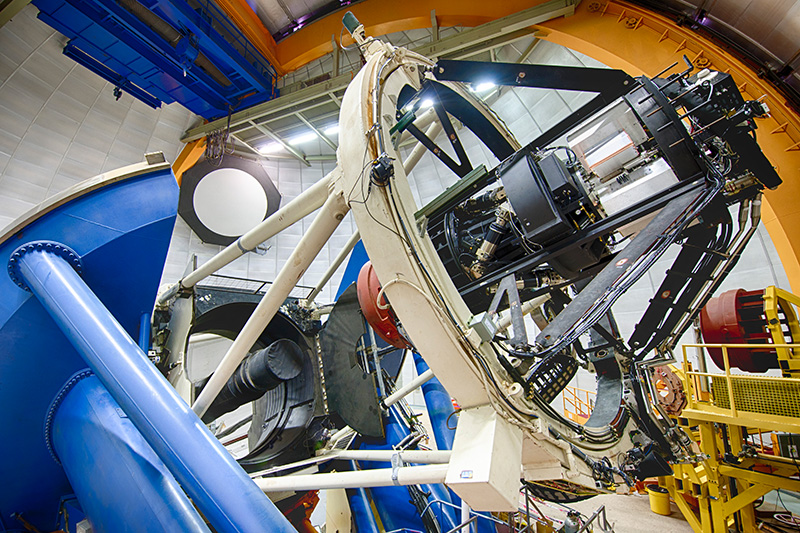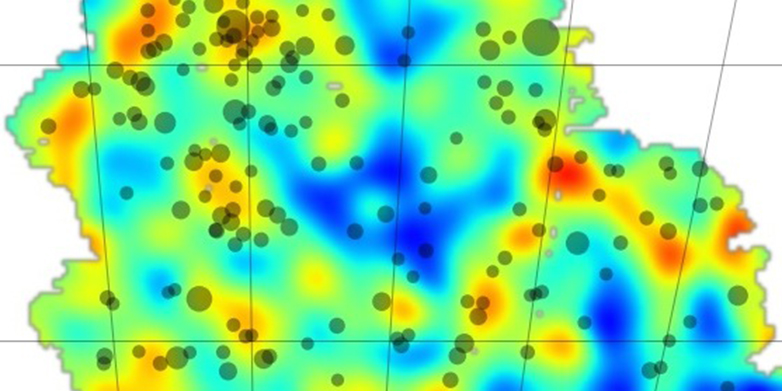Shedding light on dark matter
Two years ago, an international research collaboration set out to investigate the mysterious dark matter and dark energy in our universe. Now an ETH postdoctoral researcher has co-led a publication presenting the exciting first results. ETH professor Alexandre Refregier explains why this publication will have a high impact and whether it proves Albert Einstein wrong.
ETH News: Two years ago, the international research project called the Dark Energy Survey (DES) started its operations. Now, DES has just published the results of a study co-led by a postdoc in your group. It must be exciting news as Fermilab, the coordinating institution for the project, has announced it in a press release. What’s the big scoop?
Alexandre Refregier: DES has produced its first map of the distribution of dark matter. The study was co-led by Chihway Chang, one of the postdoctoral researchers in my research group. The region mapped in this study comprises about 140 square degrees, while DES will eventually map a region of 5000 square degrees of the southern sky. The map shows the regions of high and low dark matter density. It reveals that dark matter tends to concentrate in areas where there is a high amount of ordinary matter, for instance in galaxy clusters. This confirms our theories for the formation of structures in the universe, including galaxies and stars.

And what makes the results of this study are so extraordinary?
We use special techniques to map dark matter in the universe. Today, our universe contains only 5 per cent ordinary matter, while 25 per cent of the universe consists of dark matter and 70 per cent of dark energy. These two dark components are still a mystery and pose some of the most pressing questions in fundamental physics today. DES is an experiment designed to probe these components and characterise their properties using a method called gravitational lensing.
How does gravitational lensing work?
As dark matter does not emit light, it is invisible. However, since it has mass, it can be observed via the gravitational pull it exerts. For instance, it affects the trajectory of galaxies that are moving in its vicinity. The same gravitational effect also affects the propagation of light. As a result, the images of distant galaxies appear slightly distorted. This effect is called gravitational lensing. We can use these small distortions to reconstruct the distribution of the dark matter in the universe.
Is the map presented in this study the first dark matter map?
It is not the first time that dark matter has been mapped, but this the largest map of a contiguous area so far. There have been maps of several smaller individual regions before.
The map looks rather simple. What is the main challenge in creating such a map?
The project is much about data analysis and modeling, which are both very complex in this case. Measuring gravitational lensing is quite difficult because the distortion effect is small. We therefore have to measure the shapes of galaxies very carefully and correct for instrumental effects. We also have to measure the shape of a large number of galaxies and the distances to the galaxies.
And an ETH postdoctoral researcher did all this work?
Chihway Chang had a leading role in doing this analysis and in making the map. It is a distinction that she could contribute to DES in this way, and I am very happy about that. Her work was of course part of a team effort involving many scientists worldwide, including Adam Amara and Tomasz Kacprzak, two other young scientists in my research group at ETH.
Who is involved in DES at ETH?
Three research groups are involved and provide four members to the collaboration. Each group focuses on different aspects of astrophysics and cosmology. Marcella Carollo and her group study galaxy structure and morphology to see how galaxies evolve in different environments. Simon Lilly's group focuses on how to measure the distance to galaxies, information which is required as an input to the lensing analysis and other sciences with DES. My group focuses on questions related to dark matter, dark energy and gravity, through studies of gravitational lensing, the formation of structure in the universe and data analysis techniques.
One of the goals of the whole project is to prove Einstein’s general relativity right or wrong. Does this first paper give a hint in any direction?
It’s too early to answer this. To better understand dark energy and dark matter, and to determine whether possible modifications of Einstein’s theory of general relativity are needed, we have to analyse more data. This will allow us to measure the lensing effect with even higher precision. Then we will be able to test Einstein’s theory of general relativity. This is our current theory of gravity and it has been well tested on solar system scales. But one possibility is that it may have to be modified on very large cosmological scales.
What are the next steps?
This is the first set of data that we are analysing, and we are working hard on the next data releases. It is exciting and very hard work. The primary purpose of this data set was to show that the experiment is working, and it is! Now we have to scale up our data analysis methods, which won’t be easy. We have to rethink our methods with every major improvement.
Dark Energy Survey

external pageThe Dark Energy Survey (DES)call_made is designed to probe the origin of the accelerating universe and help uncover the nature of dark energy by measuring the 14-billion-year history of cosmic expansion with high precision. More than 120 scientists from 23 institutions in the United States, Spain, the United Kingdom, Brazil, Germany and Switzerland are working on the project. This collaboration has built and deployed an extremely sensitive 570-Megapixel digital camera, DECam. This new camera has been mounted on the Blanco 4-meter telescope at Cerro Tololo Inter-American Observatory, high in the Chilean Andes. Starting in August of 2013 and continuing for five years, DES has begun to survey a large swath of the southern sky out to vast distances in order to provide new clues to the most fundamental of questions of dark matter and the formation of galaxies.
Reference
Vikram V, Chang C, et al. Wide-Field Lensing Mass Maps from DES Science Verification Data. Published online April 13th 2015 external pagehttp://deswl.github.io/page1/vikram_paper/vikram_paper.htmlcall_made

